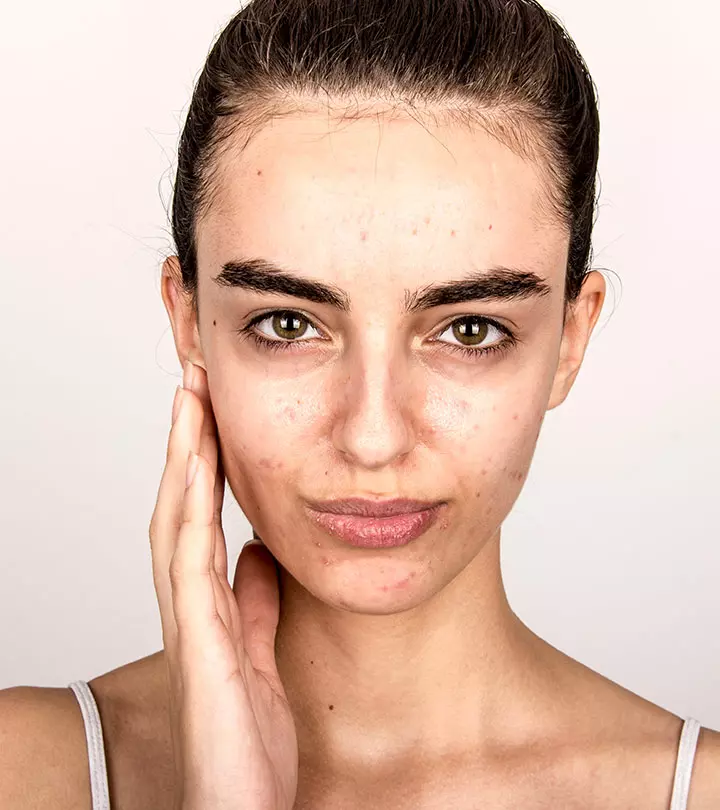Lactic Acid For Skin: Benefits, How To Use, And Side Effects
Lactic love: unveil the benefits of lactic acid for a natural glow on your skin.

Image: Shutterstock
Lactic acid has been used for skin benefits for a long time. Many use lactic acid for skin exfoliation and improving skin tone and texture. It helps remove dead skin cells, dirt, and pimple-causing bacteria to give you that much-loved flawless skin. In addition, anecdotal evidence claims that lactic acid improves firmness and glow to your skin by promoting hydration and retaining moisture. This article discusses the benefits of lactic acid, how to use it, and its potential side effects. Keep reading to know more.
In This Article
What Is Lactic Acid?
Lactic acid is a natural ingredient in dairy products such as soured milk and yogurt. Historically, dairy products such as milk have been used to beautify and smoothen the skin. Lactic acid helps moisturize the skin. It is part of the skin’s natural moisturizing complex that delivers excellent moisturizing effects to skin (1). It is produced from fermented milk or sugar and works great on sensitive skin. It is widely used in over-the-counter skin care and professional peels to conduct skin care treatments and procedures.
 Fun Fact
Fun FactKey Takeaways
- Lactic acid hydrates skin, evens its tone, reduces discoloration and acne marks, repairs skin damage, reduces signs of aging, and may even stimulate collagen production.
- If you haven’t used lactic acid before, start off with a low concentration so your skin can build tolerance for it.
- There are many lotions, creams, cleansers, masks, and serums that contain lactic acid.
- However, lactic acid can make your skin sensitive to the sun. Hence, remember to apply sunscreen before heading outdoors.
Use Of Lactic Acid In Skin Care
Lactic acid is a popular skin care ingredient. When used with a pH correcting formula, it helps reduce dry skin cells and dead skin. It is used primarily in high-strength peels to help treat acne, wrinkles, aging spots, and fine lines.
The lactic acid peel is used on bare skin to remove the topmost layer, or the epidermis. A potent formula may target the middle layer of the skin as well (the dermis). Peeling works by sloughing off the dead skin cells.
Different concentrations of lactic acid will perform differently on skin. The higher the concentration of lactic acid, the more effective the exfoliation. Using products with 5% to 12% lactic acid can offer desirable results. Ensure these products have a pH ranging from 3 to 4, as anything lower can cause skin irritation.
We will now look at the skin benefits of lactic acid in the following section.
What Are The Skin Benefits Of Lactic Acid?
- Lactic acid acts as a natural moisturizer to hydrate and replenish skin.
- It helps fade uneven skin tone and discoloration by shedding dead skin cells and renewing the skin.
- It helps fade acne marks and reveals clean and flawless skin (2).
- Lactic acid may help repair skin damage caused by UV rays. It may help reduce wrinkles, fine lines, skin dullness, etc. A lactic acid-based product with 8% to 12% concentration is recommended to treat sun damage. However, more research is warranted in this regard.
- Lactic acid is suitable for all skin types. It helps strengthen the skin barrier and improve its elasticity.
- Lactic acid may stimulate collagen production too.
How Do You Use Lactic Acid In Skin Care?
The key is to start slow. Your skin must build tolerance for the acid. Hence, opt for a product with a low concentration of lactic acid. Use once a week initially, and increase its use depending on how your skin reacts to it.
Also, perform a patch test to ensure a product is suitable for your skin type. Discontinue use if you experience any irritation or burning. It always is a great idea to consult your dermatologist before buying any lactic acid-based product for your skin.
How To Add Lactic Acid To Your Skin Care Routine
There are many products featuring lactic acid that you can include in your skin care routine. These include the following:
- Lotions And Creams
Lotions and creams are great options to be added to your skincare regime. They are packed with moisturizing and hydrating additives, such as hyaluronic acid and ceramides, which help prevent dryness.
- Facial Cleansers
A lactic acid-based face wash or cleanser is perfect for oily and acne-prone skin. Such products help reduce acne and fade post-acne scarring. However, be careful not to use the cleanser around your eyes as it may cause irritation and burning.
- Masks
Lactic acid-based masks are great for exfoliating skin. However, they may contain higher concentrations of lactic acid and other ingredients. Hence, use them only once a week.
- Serums
Serums possess potent formulas that penetrate the skin and enable effective healing. Use lactic acid-based serums at night after washing your face and before moisturization. This promotes better product absorption and activates cell renewal activity.
Avoid mixing lactic acid with products containing other AHAs, BHAs, and retinol to prevent excess dryness.
It is recommended to use lactic acid at night as it can cause UV sensitivity should you step out in the sun during the day. However, further research is warranted in this regard.
 Did You Know?
Did You Know?While lactic acid is an excellent ingredient for skin, it does have its share of side effects. We have discussed the same in the following section.
Potential Side Effects Of Lactic Acid
Lactic acid is the gentlest type of AHA, but is yet very powerful. It may make your skin more sensitive to UV rays. Hence, remember to apply sunscreen when you start with the lactic acid treatment (should you step out in the sun). Using lactic acid-based products only at night can avert this problem altogether.
Anecdotal evidence suggests that lactic acid may also cause skin redness, burning, peeling, irritation, swelling, and itching. It is alright if you initially experience a mild sensation on the skin. But if it continues or aggravates, stop use and consult a dermatologist immediately.
Dairy products have been a great help in treating skin care issues, especially natural ingredients like lactic acid. Using lactic acid for the skin has plenty of benefits because of its excellent moisturizing effects. It may help replenish the skin, manage acne, strengthen the skin barrier, improve skin elasticity, and fade uneven skin tone. You may add lactic acid to your skin care routine through lotions, creams, masks, cleansers, and serums that contain this ingredient. However, lactic acid may make your skin photosensitive, and you have to wear sunscreen if using it during the day.
Frequently Asked Questions
Which is better: retinol or lactic acid?
Retinol is a slightly stronger ingredient than lactic acid because of its capacity to penetrate the skin further and boost regeneration of skin cells. Lactic acid works only on the surface level.
Should I moisturize after using lactic acid?
Yes. Moisturization is an important step after using any kind of exfoliant on the skin. Exfoliating agents strip moisture from the skin in the cleansing process. Hence, the skin needs external moisturization.
Does lactic acid remove blackheads?
Yes. Lactic acid is a great exfoliator that removes dead skin cells from clogged skin pores, thereby aiding the removal of blackheads and whiteheads.
Can I use lactic acid and niacinamide together?
Yes. You can use lactic acid and niacinamide together. Lactic acid will work on exfoliating the skin while niacinamide can aid in rehydration after the exfoliation process.
Can I use lactic acid and hyaluronic acid together?
Yes. Lactic acid can be used with hyaluronic acid as well to help retain moisture and manage irritation caused by the exfoliating effects of lactic acid. For more information on how to combine these and other acids effectively, refer to our skin care acids guide to better understand their roles and benefits for different skin types and concerns.
Can you apply lactic acid to pimples?
No. While lactic acid may help prevent pimples by reducing pore size and firming the skin, it could aggravate existing acne and pimples.
This video will help you understand the nuances of lactic acid, which is considered a magical skincare ingredient. The video details how it benefits the skin, and the details of when and how to use it. Click play for more.
References
Articles on StyleCraze are backed by verified information from peer-reviewed and academic research papers, reputed organizations, research institutions, and medical associations to ensure accuracy and relevance. Read our editorial policy to learn more.
- Lactic Acid and Skin Microbiota
https://www.ncbi.nlm.nih.gov/pmc/articles/PMC6017965/ - Professional-Grade TCA-Lactic Acid Chemical Peel
https://www.frontiersin.org/journals/medicine/articles/10.3389/fmed.2021.617068/full
Read full bio of Dr. Sameeksha Chand
Read full bio of Arshiya Syeda
Read full bio of Ramona Sinha
Read full bio of Swathi E

























Community Experiences
Join the conversation and become a part of our empowering community! Share your stories, experiences, and insights to connect with other beauty, lifestyle, and health enthusiasts.